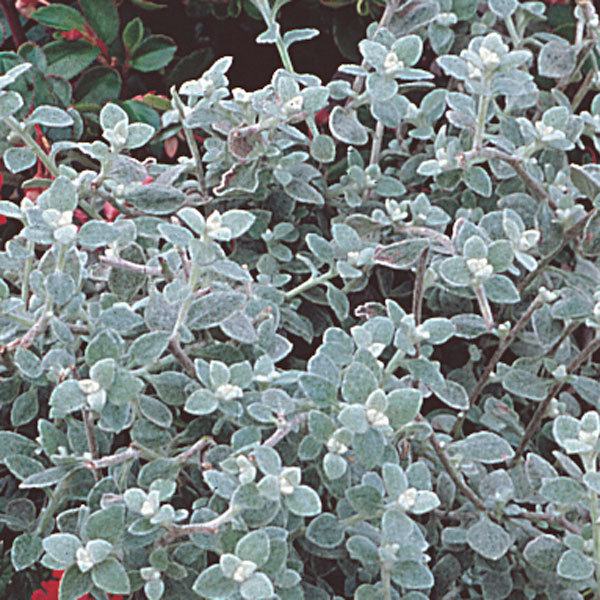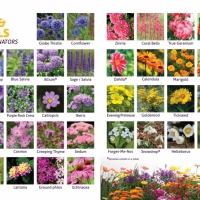Helichrysum Hybrid (Helichrysum hybrid)
Features
Beautiful silvery foliage and exceptional drought tolerance make this a terrific plant for tough locations. Provides an excellent contrast to green foliage and bright flowers. The shimmering foliage is ideal for adding color and interest to mixed container plantings.
Uses
Perfect for all kinds of containers, including window boxes, hanging baskets and combination planters. Looks great in rock gardens.
Plant Feed
Fertilize regularly for best display.
Watering
Allow soil to dry between thorough waterings.
Soil
Ordinary, well-drained soil.
Planting Instructions
Prepare the garden by breaking up the existing soil (use a hoe, spade, or power tiller). Add organic matter such as manure, peat moss or garden compost until the soil is loose and easy to work. Organic ingredients improve drainage, add nutrients and encourage earthworms and other organisms that help keep soil healthy. Give plants an extra boost by adding a granulated starter fertilizer or a balanced all-purpose feed (for example fertilizers labeled 12-12-12).
Check the plant label for suggested spacing. Crowding plants can result in fewer blooms and weak growth as the plants compete for light. Exceptions to this might be regions with a short growing season, shade plantings which tend to grow slower and fill in less quickly, or a need to fill an area with color quickly such as for a special event or if planning to entertain guests outdoors.
Remove the plant from the container. If plants are in a pack, gently squeeze the outside of the individual plant cell while tipping container to the side. If plant doesn't loosen, continue pressing on the outside of the container while gently grasping the base of the plant and tugging carefully so as not to crush or break the stem until the plant is released. If the plant is in a pot, brace the base of the plant, tip it sideways and tap the outside of the pot to loosen. Rotate the container and continue to tap, loosening the soil until the plant pulls smoothly from the pot.
Dig the hole up to two times larger than the root ball and deep enough that the plant will be at the same level in the ground as the soil level in the container. Grasping the plant at the top of the root ball, use your finger to lightly rake the roots apart. This is especially important if the roots are dense and have filled up the container. Set the plant in the hole.
Push the soil gently around the roots filling in empty space around the root ball. Firm the soil down around the plant by hand, tamping with the flat side of a small trowel, or even by pressing down on the soil by foot. The soil covering the planting hole should be even with the surrounding soil, or up to one inch higher than the top of the root ball. New plantings should be watered daily for a couple of weeks to get them well established.
Vining annuals require vertical space to grow, so provide a trellis, fence, wall or other structure that allows the plant to grow freely and spread.
Watering Instructions
New plantings should be watered daily for a couple of weeks. After that, depending on the weather and soil type, watering can be adjusted to every two or three days. Clay soils hold moisture longer than sandy soils, so expect to water more frequently in sandy settings.
Different plants have different water needs. Some plants prefer staying on the dry side, others like to be consistently moist. Refer to the plant label to check a plant’s specific requirements.
Ideally water should only be applied to the root zone - an area roughly 6-12” (15-30cm) from the base of the plant, not the entire plant. A soaker hose is a great investment for keeping plants healthy and reducing water lost through evaporation. Hand watering using a watering wand with a sprinkler head attached is also a good way to control watering. If the garden area is large, and a sprinkler is necessary, try to water in the morning so that plant foliage has time to dry through the day. Moist foliage encourages disease and mold that can weaken or damage plants.
To check for soil moisture use your finger or a small trowel to dig in and examine the soil. If the first 2-4” (5-10cm) of soil is dry, it is time to water.
Fertilizing Instructions
Fertilizers are available in many forms: granulated, slow-release, liquid feeds, organic or synthetic. Determine which application method is best for the situation and select a product with a nutritional balance designed to encourage blooming (such as 5-10-5).
Too much fertilizer can actually damage plants so it’s important to follow the package directions to determine how much, and how often, to feed plants.
Pruning Instructions
Prune plants freely to maintain the desired size and shape. Pinching plants back stimulates dense, bushy new growth and encourages more flowers.
Remove old flowers to keep plant looking healthy and prevent seed production that drains the plant’s energy at the expense of forming new flowers.
Some plants are grown only for their attractive foliage (such as coleus, dusty miller and flowering kale). Their flowers are not very showy and any buds should be pinched off to keep the foliage looking its best.
Plant Details
| Available Colors: | Grown for foliage |
| Bloom Time: | Grown for foliage |
| Height Range: | 8-12" (20-30cm) |
| Space Range: | 15-18" (38-46cm) |
| Temperature Range: | 30° to 40°F (-1° to 4°C) |
| Plant Light: | Full Sun |
| Companion Plants: | Coneflower, Upright Stonecrop, Black Eyed Susan |
Availability
- Jan
- Feb
- Mar
- Apr
- May
- Jun
- Jul
- Aug
- Sep
- Oct
- Nov
- Dec



